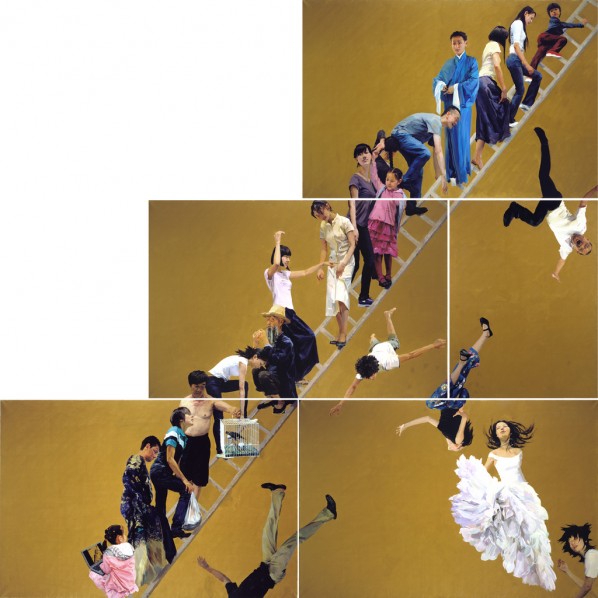Having interpreted Chinese woman art in the 20th century from a unique perspective, this exhibition took place at Art Museum of the Centre Academy of Fine Arts from Dec. 17, 2010 to Feb. 20, 2011. It was entitled as “self-Image” to summarize and demonstrate the works within the first generation of modern woman artists grown up in 1920s and those grown up in the 21st Century. Here the “self Image” is rather referring to the nature of the work, but not emphasizing the type of the Image, i.e. the meaning and method of self-analysis, self-sculpting and self-identification.
The exhibition is also a vehicle for the informed conclusions of its curator, acknowledged women's issues expert Yao Daimei, on Chinese women artists and their self-perceptions based on her years of research and observations. For her, “Self-Image” means both true self-image depicting the artist in the narrow sense, and paintings, sculptures and some combined works of the artists’ images but delivering her own expression and narration. Thus the exhibition begins with a powerful self-portrait by Pan Yuliang from 1940 and is divided into two main sections of Chinese women's art during the Republic of China (1920-1949) period, and Chinese women's self-image since the founding of New China.

Self Portrait by Yuliang Pan
This exhibition provides some of woman artists’ portraits by different periods and different types, and supplements with some background information and historical records, so as to demonstrate Chinese woman artists’ self-depiction, and reveal the complex relationship between “individual” and “time” behind those images. Self-Image accompany the whole process of Chinese woman art’ development from birth to maturity, to the change of self identity, as well as to the upgrade of media and subject. In addition, the said “woman art” particularly means woman artists’ self representations, which emphasize woman as the main subject to deliver self image and self existence. They are not necessarily critical narration, but emotional narration full of self experience of life instead.
The self-centered, self-love and biographical nature of “self-Image” is somewhat naturally identical with Chinese women’s personality psychology developed in the long history and natural life. In 1920s, the first generation of woman artists who had received formal artistic education have grown up, they unexceptionally demonstrated their genius and enthusiasm in portrait, especially self-portrait. On the first national art exhibition held by the National Government in April 1929, woman artists’ overall strength and favor in Image and self-portrait attracted people’s concern. Later on, self-portrait/sculpture became and remains the favorite form of woman artists, as well as exists as their important way of expression. Even in the period from 1950 to 1970 when the “individualism” was completely uprooted, their own images were still hidden behind various woman images. Since 1978 when the reform and opening up policy was adopted, the artistic form secretly revitalized, rapidly developed and greatly diversified…In the 100 years to the 20th century, Chinese woman art experienced great progresses with each passing day, but what remains unchanged is woman artists’ works always contains the nature and taste of self Image more or less. It should be attributed not only to the historic experience of woman in the past century, from self-awakening, self-recognition, self-establishment and self-development, but also to the psychological characteristics featuring tenderness and self-restraint. They depict and identify woman existence not only via content but also via form.
Artists:
Yang AU(歐洋), Baohua BIAN(邊寶華), Yilong CAI(蔡憶龍), Shuxia CHEN(陳淑霞), Ke CHEN(陳可), Xi CHEN(陳曦), Yanan CHENG(程亞男), Shu DENG(鄧澍), Junbi FANG(方君璧), Zilan GUAN(關紫蘭), Mojong HOO(賀慕群), Yan JIANG(姜燕), Jie JIANG(姜杰), Xueying JIANG(姜雪鷹), Nu JIN(金釹), Shuang LEI(雷雙), Qingping LI(李青萍), Tianmiao LIN(林天苗), Jingjing LIN(林菁菁), Hong LIU(劉虹), Manwen LIU(劉曼文), Yan LIU(劉彥), Yang LOU(樓陽), Guoying LU(陸國英), Xueyan LUAN(欒雪雁), Morye(莫也), Fangqian NING(寧方倩), Yuliang PAN(潘玉良), Ti QIU(丘堤), Jingkun SHAO(邵晶坤), Ling SHEN(申玲), Na SHEN(沈娜), Ying SUN(孫瑩), Hongmin SUN(孫紅敏), Yun SUN(孫昀), Yanping WANG(王彥萍), Yujue WANG(王玉玨), Xia WANG(王霞), Henei WANG(王合內), Qi WANG(王琪), Peng WANG(王芃), Xiaohui WANG(王小蕙), Min WANG(王敏), Bao WEN(溫葆), Jinghan WU(吳靜涵), Junna XIA(夏俊娜), Jing XIANG(向京), Shufang XIAO(蕭淑芳), Guozhen XING(邢國珍), Lijun XIONG(熊莉鈞), Hualing XU(徐華翎), Ping YAN(閆平), Fan YANG(楊帆), Shuqing YANG(楊淑卿), Chunhua YANG(楊春華), Ying YANG(楊櫻), Yinfang YANG(楊蔭芳), Nan YE(葉南), Feng YU(郁風), Chen YU(余陳), Hong YU(喻紅), Youlan ZHANG(張幼蘭), Qianying ZHANG(張倩英), Yanzi ZHANG(章燕紫), Xiaorui ZHANG(張笑蕊), Jihua ZHAO(趙際華), Zheng ZHAO(趙禎), Youping ZHAO(趙友萍), Rongfeng ZHAO(趙榮鳳), Xiaomo ZHAO(趙曉沫), Shuang ZHENG(鄭爽), Xin ZHOU(周昕), Licun ZHU(朱理存)

Ladder to Heaven by Hong Yu 2008

Stockings by Yanzi Zhang
View the Chinese version of this article here




























